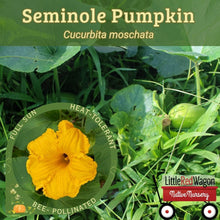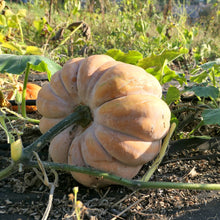Seminole pumpkin (Cucurbita moschata) is a vigorous, heat-tolerant vine that thrives in Florida’s hot, humid conditions and sandy, well-drained soil. Though not native, it has adapted well to the region and was traditionally cultivated by the Creek and Miccosukee peoples. This tan-colored fruit with deep orange flesh is compact, round, and exceptionally sweet—often compared to butternut squash but with a richer flavor. Ideal for USDA zones 8–10, it flourishes in full sun and benefits from consistent moisture without overwatering. Pollinated by bees or hand, Seminole pumpkins are planted from March to June and produce excellent fruit that can last up to a year at room temperature. Their stringless flesh is perfect for baking, roasting, steaming, or making pies, and the seeds can be roasted or saved for future planting.
- Vine
- Non-native to Florida
- Size: 25 ft. by 25 ft.
- Flower: Orange
- Fruit: Tan or buff-colored
- Exposure: Full sun
- Moisture: Well-drained, sandy soil
- Heat-tolerant
- Pollinated by bees and other pollinators
- Planting time: March - June
/mp




